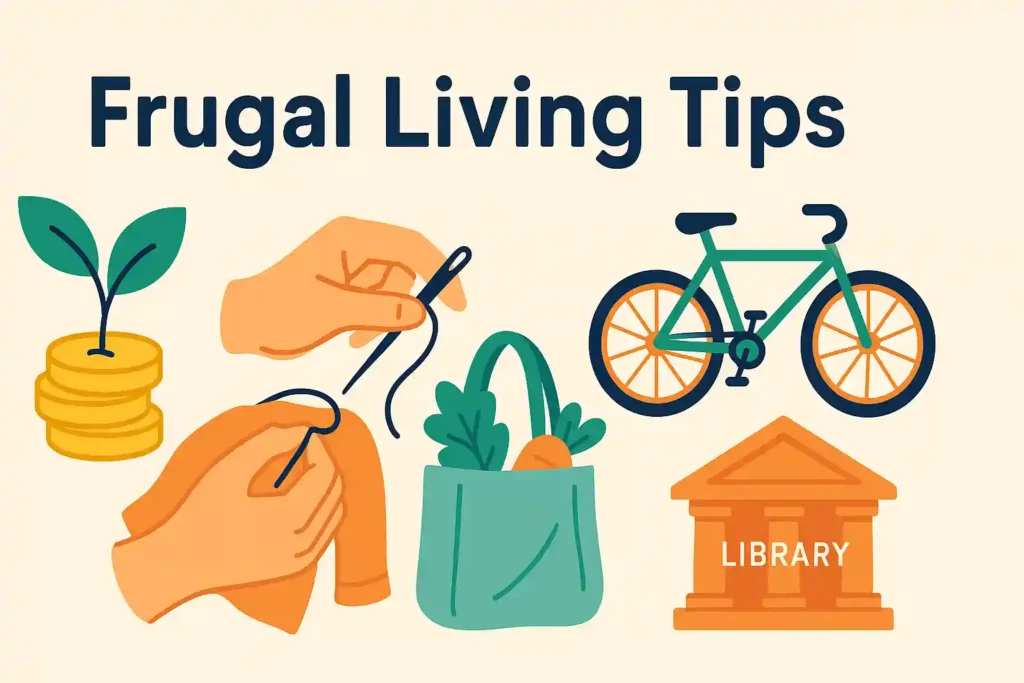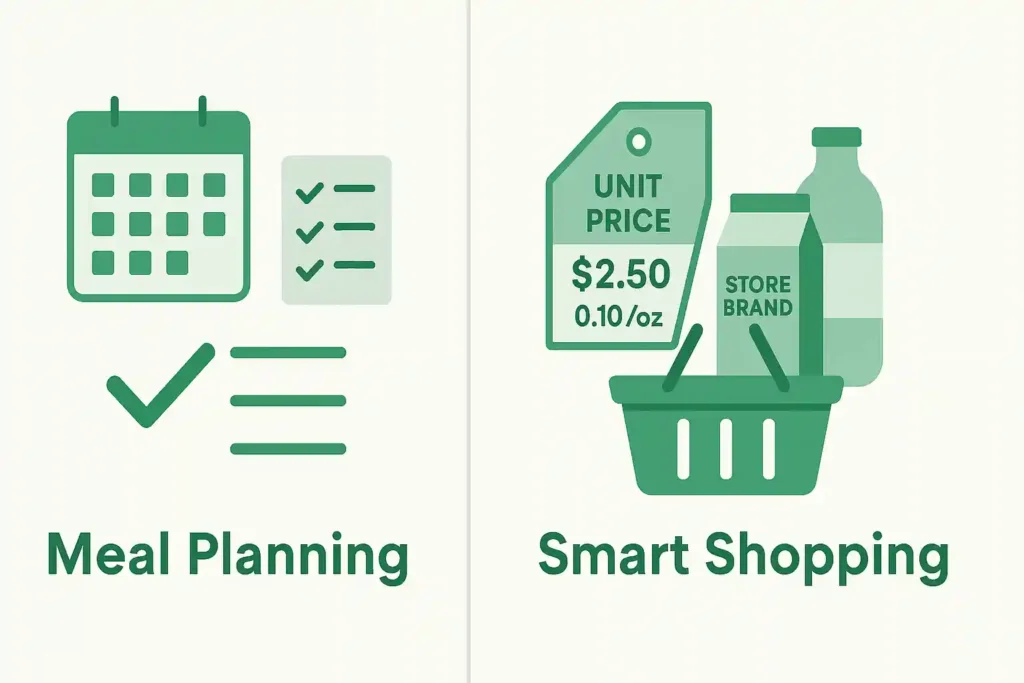Does your paycheck seem to disappear faster than you can say “direct deposit”? Are rising costs making you feel squeezed, stressed, or like you’re constantly running on a financial treadmill? You’re not alone. But what if there was a way to spend less, save more, reduce that financial anxiety, and actually feel more in control and content? Welcome to the world of frugal living. Forget the old stereotypes of misery and deprivation; modern frugality is about resourcefulness, intentionality, and aligning your spending with your values.
This guide is packed with over 50 actionable tips for frugal living covering every area of your life – from the kitchen to your closet, from your bills to your mindset. We’ll explore practical strategies to cut costs significantly without sacrificing your quality of life. Get ready to discover how living frugally can unlock financial freedom and maybe even a happier, simpler life.

Table of Contents
Redefining Frugality: Intentional Spending, Not Deprivation
Before we dive into the tips, let’s clear up some misconceptions. Frugality often gets a bad rap, confused with being stingy or cheap. That couldn’t be further from the truth.
Frugal vs. Cheap: Understanding the Key Difference
- Cheap: Often about spending the absolute least amount of money possible, regardless of quality, value, ethics, or impact on others. It can sometimes mean cutting corners inappropriately.
- Frugal: About being resourceful and prioritizing value. It’s about mindful spending – allocating your money intentionally towards things that truly matter to you and minimizing waste on things that don’t. It’s about getting the most value out of your resources (time, money, energy).
Frugality isn’t about never spending money; it’s about spending money wisely on things that align with your goals and values.
The Powerful “Why”: Benefits of Embracing Frugal Living
Why adopt a more frugal lifestyle? The benefits extend far beyond just saving money:
- Financial Freedom: Less debt, more savings, ability to pursue goals (early retirement, travel, career change).
- Reduced Stress: Less anxiety about bills, emergencies, or unexpected expenses.
- Increased Control: Feeling empowered over your finances instead of controlled by them.
- More Sustainability: Often involves less consumption, less waste, and more mindful use of resources.
- Enhanced Creativity & Resourcefulness: Finding clever ways to save and make do can be surprisingly satisfying.
- Greater Appreciation: Learning to value experiences and non-material things more.
Beginning with Basics: Essential Tips for Frugal Living
You don’t need to implement all 50+ tips overnight! Pick a few that resonate most or seem easiest to start with. Frugality is a muscle; it gets stronger with practice.
Mastering the Kitchen: Your Ultimate Guide to Frugal Eating
Food is often one of the largest variable expenses. Dialing this in offers huge savings potential.
- Meal Plan Religiously: Plan your meals for the week before grocery shopping. This is the #1 tip for saving money on food.
- Shop with a List (and Stick to It): Only buy what’s on your pre-planned list to avoid impulse purchases.
- “Shop” Your Pantry First: Check what you already have before making your list to avoid duplicates.
- Compare Unit Prices: The largest package isn’t always the cheapest per ounce/gram. Do the math!
- Buy Generic/Store Brands: Often significantly cheaper than name brands for similar quality staples (flour, sugar, canned goods, etc.).
- Embrace Sales & Coupons (Strategically): Stock up on non-perishables when they’re deeply discounted, but only buy what you’ll actually use. Use digital coupons if convenient.
- Cook from Scratch: Processed and pre-made foods cost much more than their base ingredients. Learn simple recipes.
- Eat Less Meat (or Go Meatless More Often): Meat is expensive. Incorporate more beans, lentils, eggs, and tofu.
- Buy Produce In-Season & Locally: Often cheaper and fresher. Check local farmer’s markets (like community souks or stands) near the end of the day for potential deals.
- Reduce Food Waste: Use leftovers creatively, store produce properly, understand “best by” vs. “use by” dates, freeze extras.
- Batch Cook & Freeze Meals: Cook large portions and freeze individual servings for easy, cheap future meals (great for lunches!).
- Pack Your Lunch & Snacks: Avoid expensive work lunches or vending machine runs.
- Brew Your Own Coffee/Tea: Daily cafe visits add up incredibly fast. Invest in a good coffee maker or kettle.
- Drink More Water (from the Tap!): Skip sugary drinks and expensive bottled water. Use a reusable water bottle.
- Grow Some of Your Own Food: Even a small herb garden on a windowsill can save money and add flavor.
Home Smart Home: Frugal Living Tips for Housing Costs
Your home base offers many opportunities to trim expenses.
- Adjust Your Thermostat: A few degrees cooler in winter and warmer in summer makes a big difference. Use programmable thermostats.
- Seal Air Leaks: Check windows and doors for drafts and use weather stripping or caulk.
- Switch to LED Lighting: LEDs use significantly less energy and last much longer than traditional bulbs.
- Unplug “Vampire” Electronics: Many devices draw power even when off. Use power strips to easily switch them off completely. (Check Energy Star resources from gov sites like EPA in the US (https://www.energystar.gov/) for appliance efficiency tips).
- Use Appliances Efficiently: Run full loads in dishwashers/washing machines, use cold water for laundry when possible, air dry clothes.
- Conserve Water: Take shorter showers, fix leaky faucets promptly, install low-flow fixtures.
- Re-evaluate Housing Needs: Could you comfortably live in a smaller space (downsizing)? Consider house-hacking (renting out a room) if feasible and culturally appropriate. (Long-term strategies).
- Learn Basic DIY Maintenance: Simple plumbing fixes (leaky faucet), patching drywall, or basic appliance troubleshooting can save costly repair calls. YouTube is your friend!
- Shop Around for Home/Renters Insurance Annually: Don’t auto-renew without comparing quotes.
Moving Smarter: Frugal Transportation Tips
Getting from A to B doesn’t have to break the bank.
- Drive Less: Walk, bike, use public transportation, or carpool whenever possible. Combines savings with health/environmental benefits.
- Maintain Your Vehicle: Regular oil changes, tire pressure checks, and preventative maintenance improve fuel efficiency and prevent costly breakdowns.
- Compare Car Insurance Rates Regularly: Loyalty rarely pays. Get quotes from multiple insurers annually.
- Plan Errands Efficiently: Batch errands together to minimize driving trips and save fuel/time.
- Consider Fuel Efficiency When Buying a Car: Factor in long-term fuel and maintenance costs, not just the purchase price.
- Utilize Fuel Apps/Programs: Apps like GasBuddy (US) or local equivalents can help find cheaper gas prices.
Conscious Consumerism: Frugal Shopping Strategies
Shift from mindless buying to intentional purchasing.
- Implement a Waiting Period: For non-essential purchases, wait 24 hours, 7 days, or even 30 days. The urge often passes.
- Buy Used/Secondhand First: Explore thrift stores, consignment shops, online marketplaces (Facebook Marketplace, Vinted, local equivalents), garage sales for clothing, furniture, books, tools, etc. It’s often cheaper and more sustainable.
- Repair Before Replacing: Learn basic sewing skills, fix broken items if possible (shoes, electronics, furniture).
- Borrow or Rent Instead of Buying: For items used infrequently (special tools, formal wear, sporting equipment), check libraries of things, rental shops, or borrow from friends/neighbors.
- Utilize the Library: Free access to books, e-books, audiobooks, movies, magazines, sometimes even museum passes or tool lending!
- Find Free Entertainment: Explore parks, hiking trails, free museum days, community events, picnics, game nights at home.
- Unsubscribe & Unfollow: Remove temptation by unsubscribing from marketing emails and unfollowing brands/influencers that trigger impulse buys.
- Negotiate Bills: Regularly call providers for cable, internet, phone, and insurance to ask for better rates or promotions. Mentioning competitor offers can help. Know your rights as a consumer regarding billing (check resources like the FTC in the US – https://consumer.ftc.gov/).
- Master Gift-Giving Frugally: Offer experiences, homemade gifts, acts of service, or pool money for group gifts instead of buying expensive individual items.
- Avoid Shopping as Entertainment: Find other ways to spend your free time.
Embracing Resourcefulness: Deeper Frugal Living Habits
Frugality can become a fulfilling lifestyle rooted in resourcefulness and mindset.
- DIY Cleaning Supplies: Use simple, cheap ingredients like vinegar, baking soda, and water for many cleaning tasks.
- Learn Valuable Skills: Cooking, baking, sewing, mending, basic home/car repair, gardening – these skills save money repeatedly.
- Practice Contentment: Appreciate what you already have instead of constantly chasing the next new thing. Gratitude journals can help.
- Focus on Experiences, Not Just Things: Memories from experiences often bring more long-term happiness than material possessions. Prioritize spending accordingly.
- Set Financial Goals: Knowing why you’re saving makes it easier to cut back on spending that doesn’t align with your priorities. (See our guide on [Setting Financial Goals] (<- If applicable, link internally )).
- Learn to Say “No” Gracefully: Don’t feel pressured into expensive outings, trips, or purchases you can’t afford or don’t value. Suggest cheaper alternatives.
- Embrace Minimalism (to your comfort level): Owning less often means spending less, less cleaning/maintenance, and less desire for more stuff.
- Connect Frugality & Sustainability: Many frugal practices (reducing waste, buying used, consuming less) are inherently eco-friendly. Find motivation in both aspects.
- Find Your Frugal Community: Connect with like-minded people online or offline for support, tips, and inspiration.
- Track Your Progress & Celebrate Wins: Seeing how much you’re saving motivates you to keep going! Acknowledge your efforts.
- Automate Savings: Set up automatic transfers to your savings account so the money is saved before you’re tempted to spend it.

Common Questions About Embracing Frugal Living
Let’s address some frequent questions:
- How can I live frugally without feeling totally deprived? The key is intentionality. Frugality isn’t about cutting out everything you enjoy; it’s about cutting back mindlessly spending on things that don’t bring you value, so you have more money for the things that do. Focus on value, experiences, and finding free/low-cost alternatives for enjoyment. It’s about optimizing, not eliminating joy.
- What are the easiest frugal habits for beginners to start with? Some easy wins include packing your lunch, brewing coffee at home, making a grocery list and sticking to it, implementing a 24-hour waiting period for non-essential purchases, and checking the library before buying books/movies. Start small!
- Does being frugal mean I’m cheap? Not at all! Cheapness often disregards value and impact on others. Frugality is about resourcefulness, prioritizing value, and making smart choices with your money. A frugal person might spend more on a high-quality item that will last for years, while a cheap person might buy the lowest-priced item that breaks quickly.
- How much money can I realistically save by living frugally? This varies hugely based on your starting spending habits, income, and commitment level. However, by implementing tips across food, housing, transportation, and shopping, many people can save hundreds, even thousands, of dollars/euros/pounds per month compared to their previous spending. Tracking your savings is the best way to see your personal impact.
- Can frugal living actually make me happier? Many people find it does! Reducing financial stress, feeling in control of money, having more resources for meaningful goals, and appreciating simple pleasures can significantly boost well-being and contentment. It shifts focus from consumption to experiences and values.
Your Journey to Financial Freedom Starts Here
Embracing tips for frugal living is about more than just pinching pennies; it’s a powerful strategy for taking control of your finances, reducing stress, living more sustainably, and ultimately, building a life aligned with your deepest values and goals. It empowers you to direct your resources towards what truly matters.
Don’t feel pressured to implement everything at once. Choose one or two tips from this list that seem achievable for you this week. Start there. Build momentum. Celebrate your resourcefulness and the savings you achieve. You might just discover that living frugally isn’t about restriction, but about liberation.
Call to Action:
What’s one frugal living tip from this list you’re going to try this week? Or do you have a favorite frugal hack not mentioned here? Share your thoughts and experiences in the comments below – let’s learn from each other!
If you found these tips helpful, please share this guide with others looking to save money and live more intentionally!



